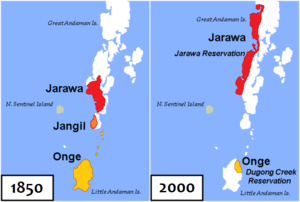Ongan languages
| Ongan | |
|---|---|
| South Andamanese | |
| Geographic distribution | language families |
Early form | Proto-Ongan
|
| Subdivisions |
|
| Glottolog | jara1244 |
 Distribution of the Ongan languages prior to 1850 (Fig. 1) and in 2005 (Fig. 2) | |
Ongan, also called Angan,[1] South Andamanese or Jarawa–Onge, is a phylum which comprises two attested Andamanese languages spoken in the southern Andaman Islands.
The two known extant languages are:
- Onge) in 1997, mostly monolingual
- Jarawa) in 1997, monolingual
External relationships
The attested Andamanese languages fall into two clear families, Great Andamanese and Ongan.
The similarities between Great Andamanese and Ongan are mainly of a typological and morphological nature, with little demonstrated common vocabulary. Linguists, including long-range researchers such as Joseph Greenberg, have expressed doubts as to the validity of Andamanese as a family.[2]
It has since been proposed (by Juliette Blevins 2007) that Ongan (but not Great Andamanese) is distantly related to Austronesian in a family called Austronesian–Ongan.[3] However, the proposal of a genealogical connection between Austronesian and Ongan has not been well-received by other linguists. George Van Driem (2011) considers Blevins' evidence as "not compelling", although he leaves the possibility open that some resemblances could be the result of contact/borrowing, a position also held by Hoogervorst (2012).[4][5] Robert Blust (2014) argues that Blevins' conclusions are not supported by her data, and that of her first 25 reconstructions, none are reproducible using the comparative method. Blust concludes that the grammatical comparison does not hold up, and also cites non-linguistic (such as cultural, archaeological, and biological) evidence against Blevins' hypothesis.[6]
Reconstruction
The two attested Ongan languages are relatively close, and the historical sound reconstruction mostly straightforward:
| Proto-Ongan | *p | *b | *t | *d | *kʷ | *k | *ɡ | *j | *w | *c | *ɟ | *m | *n | *ɲ | *ŋ | *l | *r |
|---|---|---|---|---|---|---|---|---|---|---|---|---|---|---|---|---|---|
| Jarawa | p, b | b | t | d | hʷ, h | h | ɡ, j | j | w | c | ɟ | m | n | ɲ | ŋ | l | r |
| Onge | b | b | t, d | d, r | kʷ, h | k, ɡ | ɡ, Ø | j | w | c, ɟ | ɟ | m | n | ɲ | ŋ | l, j | r/j/l, Ø |
| Proto-Ongan | *i | *u | *a | *e | *o | (*ə) |
|---|---|---|---|---|---|---|
| Jarawa | i | u | a | e, ə, o | o | (ə) |
| Onge | i | u | a | e, ə, o | o | (ə) |
*ə appears to be allophonic for *e before a nasal coda.
Grammar
The Ongan languages are
The Ongan pronouns are here represented by Önge:
| I, my | m- | we, our | et-, ot- |
| thou, thy | ŋ- | you, your | n- |
| he, his, she, her, it, its | g- | they, their | ekw-, ek-, ok- |
There is also an indefinite prefix ən-, on- "someone's". Jarawa does not have the plural series, but the singular is very close: m-, ŋ- or n-, w-, ən-. From this, Blevins reconstructs Proto-Ongan *m-, *ŋ-, *gw-, *en-.
Judging from the available sources, the Andamanese languages have only two
See also
- List of Proto-Ongan reconstructions (Wiktionary)
References
- ^ Abbi, Anvita. 2013. A Grammar of the Great Andamanese Language. Brill's Studies in South and Southwest Asian Languages, Volume 4.
- ^ Greenberg, Joseph (1971). "The Indo-Pacific Hypothesis." Current Trends in Linguistics Vol. 8, ed. by Thomas A. Sebeok, 807.71. The Hague: Mouton.
- S2CID 143141296
- ^ van Driem, George (2011). "Rice and the Austroasiatic and Hmong-Mien homelands". In N.J Enfield (ed.). Dynamics of human diversity: the case of mainland Southeast Asia. Canberra: Pacific Linguistics. Retrieved 13 November 2021.
- ^ Hoogervorst, Tom (2012). Southeast Asia in the ancient Indian Ocean world: combining historical linguistic and archaeological approaches (PhD thesis). University of Oxford. Retrieved 13 November 2021.
Nevertheless, it is conceivable that some of the given forms are genuinely related, though better explained as loans than common inheritance (p. 91).
- ^ Blust, Robert (2014). "Some Recent Proposals Concerning the Classification of the Austronesian Languages", Oceanic Linguistics 53:2:300–391. "To put it bluntly, the AON hypothesis is a castle built on sand, an elaborate illusion fostered by the misplaced hope that a major discovery has been made that somehow eluded the investigations of all other scholars."
- ^ a b Blevins (2007), pp. 163–164.
- ISBN 978-3-89586-866-5.
- ^ a b Temple, Richard C. (1902). A Grammar of the Andamanese Languages, Being Chapter IV of Part I of the Census Report on the Andaman and Nicobar Islands. Port Blair: Superintendent's Printing Press.
- ^ a b Burenhult, Niclas (1996). "Deep Linguistic Prehistory with Particular Reference to Andamanese". Working Papers, Lund University, Dept. Of Linguistics. 45: 5–24.
Further reading
- Das Gupta, D. and S. R. Sharma. A Handbook of the Önge Language. Anthropological Survey of India: Calcutta 1982.
- E. H. Man, Dictionary of the South Andaman Language, British India Press: Bombay 1923.
- Senkuttuvan, R. 2000. The Language of the Jarawa: Phonology. Calcutta: Anthropological Survey of India, Government of India, Ministry of Culture, Youth Affairs, and Sports, Dept. of Culture.
- Sreenathan, M. 2001. Jarwa - Language and Culture. Anthropological Survey of India, Ministry of Culture, Government of India, Kolkata
